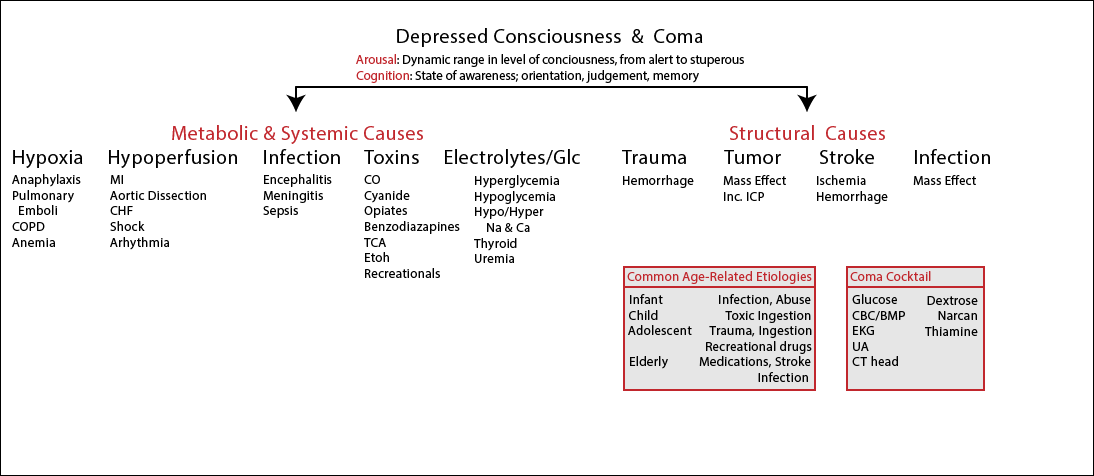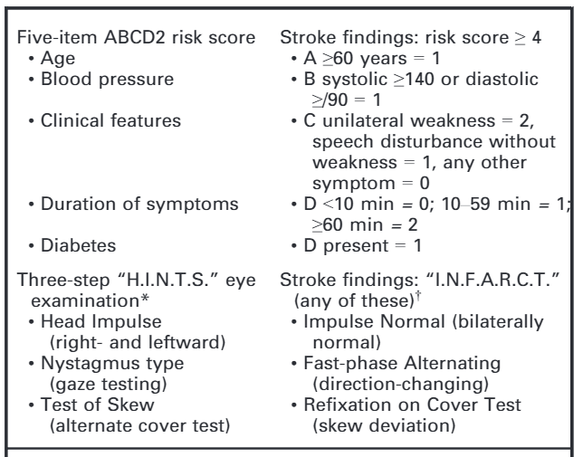|
Dizziness can be difficult to assess in the ED given the vast range of etiologies and varying ways patients interpret their symptoms. Additionally, not all patients with emergency conditions will present with obvious focal deficits. A clinical decision making rule (HINTS) can help to more rapidly identify stroke patients to initiate acute therapies faster. The HINTS rule outperforms ABCD2 for stroke diagnosis in the ED when performed by qualified practitioners in patients with Acute Vestibular Syndrome. Typically, patients with peripheral vertigo appear to have an acute change and may be very ill appearing, with nausea and vomiting and severe vertigo symptoms. Those with central vertigo typically have a more insidious onset, constant symptoms, and typically less severe symptoms. Common Causes
Signs of a Central CauseSymptoms of a central vertigo may be difficult to identify. Typically, there are some of the "5 D's"
HINTS ExamLINK TO 8 MINUTE HOW TO VIDEO Indications of a Central Cause:
Pharmacologic Management
0 Comments
The NIH stroke scale it used to identify the severity of stroke like symptoms, and should be scored on the patient's initial presentation, without coaching or duplication. It is important to be consistent when scoring all patients, and identify all deficits.
NIH stroke scale scores patients 0-42, with higher scores indicating increased severity. Training for appropriate use of the NIH stroke scale is free, at http://nihss-english.trainingcampus.net/ iPhone applications, such as StatCoder, are available and free. Adapted from Rosens, chp 16. Little Old Lady Workup (LOL)Testing to consider in an elderly patient with altered mental status ABG: hypoxia, CO2 retention, SOB BMP/CMP: electrolyte abnormalities, hepatic encephalopathy UA: infection, DKA, ingestion PT/INT: hemorrhage, anemia, hypercoagulable Lactate: ketotic state, ingestion, ischemia TSH: thyroid storm, hypothyroid Cardiac Enzymes: MI, ischemia, cardiogenic shock CXR: infection, pneumothorax, CHF CT head: hemorrhage, mass MRI: edema, mass, ischemia CTA: pulmonary emboli, aortic dissection LP/CSF: infection, ICP Confusion
Adapted from a presentation by Ty Nichols, 12/2/2015 Dizziness can be difficult to assess in the ED given the vast range of etiologies and varying ways patients interpret their symptoms. Additionally, not all patients with emergency conditions will present with obvious focal deficits. A clinical decision making rule (HINTS) can help to more rapidly identify stroke patients to initiate acute therapies faster. The HINTS rule outperforms ABCD2 for stroke diagnosis in the ED when performed by qualified practitioners in patients with Acute Vestibular Syndrome. |
Categories
Archive
February 2018
Please read our Terms of Use.
|
||||||||||






